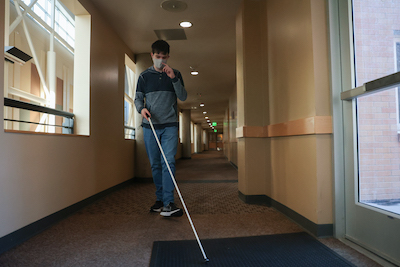Disability Services Spotlight: White Canes
December 2, 2021

For a student who is blind and uses a white cane, negotiating the Idaho State University campus can be a tricky business. Two students who are blind, Bryant Walker and Nicole Hill, shared some of their experiences using canes to get around to their classes and living quarters.
“We use orientation and mobility,” said Hill, a sophomore from Ammon majoring in general studies. “Orientation is trying to figure out where we are. Mobility is using our canes. Our cane is our eyes. It will ‘see something’ before we run into it. It isn’t perfect, but it is a tool we use.”
Hill suggested that, if you see a person who is blind using a white cane and walking toward you, you should try to move out of their way.
“My friends and I have a joke,” Hill said about people who are not aware of how problematic it is when people don’t make an adjustment like this. “We call them ‘trees’ because they just stand there.”
Walker, a senior from Weiser who will graduate this December with a bachelor’s degree in communications, said that using a white cane usually allows him to be very independent, but a cane is harder to use in crowded areas. When it is crowded, he said, he keeps his cane closer to his body and shortens its movements.
Walker noted there are many different types of white canes used, including those made from graphite, aluminum, fiberglass, and carbon fiber.
“Some are more flexible than others; some tend to bend or break more easily; others provide you with more feedback through your hand when you hit the ground with them,” he said.
Overall, both students said it was relatively easy to get around the ISU’s main campus in Pocatello once they became orientated to it.
“One reason I come to campus early before the other students show up is that the sidewalks are emptier and it is easier for me to navigate campus without having to worry about a bunch of students...at least at first,” Walker said.
Older, cracked sidewalks pose additional challenges for a person who is blind who is using a white cane because the cane can get caught in cracks and the footing is unsure. Walker said that he uses two techniques when using a cane: either swaying the cane back and forth in front of him on the ground (called the “constant contact” technique) or using a two-point touch technique when he taps the cane’s tip in front of him on the ground. He uses the latter technique when traveling on cracked, older sidewalks.
“As far as how accessible ISU is, in my experience ISU’s sidewalks and things are pretty easy to navigate mobility-wise,” Hill said. “Once you get an orientation, a mental map in your head, you are good to walk around.”
She said she appreciates it when someone asks if she needs help, but offered this general opinion regarding people interacting with people who are blind. “If you see a blind person, don’t assume they need help, and always ask before you do something,” Hill said. “So, if I’m trying to cross a street, someone could come and ask if I need help crossing.”
Hill said she appreciates it when people tell her, “Hey, it is safe to cross.” One spot that does give Hill trouble, however, is the T-intersection at Martin Luther King Way and Cesar Chavez Way.
“T-intersections are really hard to cross because we are taught to go with the surge of traffic, but with a ‘T’ there is not a surge of traffic, so I am not sure when it is safe,” Hill said.
ISU Disability Services and Facilities Services work together to address accessibility issues on campus, such as the one posed by this intersection. “Our students' safety is very important to us,” said Karina Rorris, Disability Services director. “As a result, the Disability Services office works very closely with ISU Facilities Services to improve and maintain accessibility on campus. Sometimes this requires partnering with the city and other regional partners as well.”
Rorris said that Facilities Services has made “many amazing changes” on campus and has several projects in the pipeline. For instance, ISU is putting in a new accessible sidewalk from Fifth to Eighth Avenues along the ISU side of Carter Street. Construction on this project will begin in spring 2022.
In addition, ISU is applying for grant funding for a similar accessible sidewalk project on Humbolt Street along the G-1 parking lot for 2024-2025 funding. Rorris said that ISU collaborates closely with Bannock Transportation Planning Organization, the City of Pocatello, Southeast Idaho Council of Governments, Pocatello Regional Transit, Idaho Transportation Department, and other local service agencies to pursue grant and shared funding for mobility and accessibility improvement projects on and around the Pocatello campus.
To address any accessibility concerns or issues on ISU campuses, students, faculty, staff and visitors can use ISU’s Campus Accessibility Request Form.
Categories:
